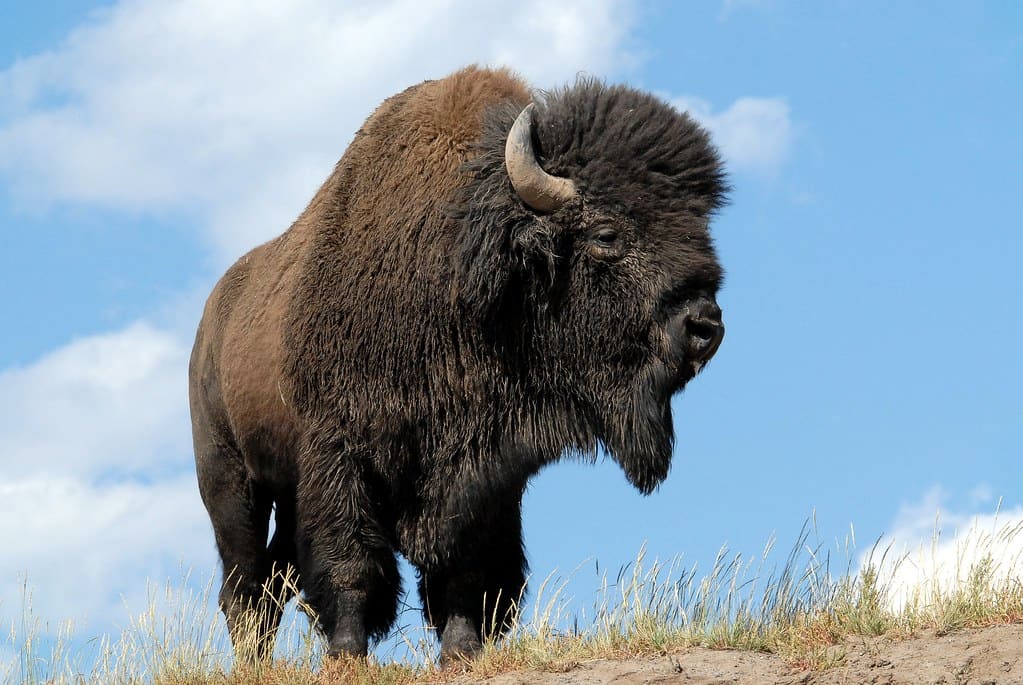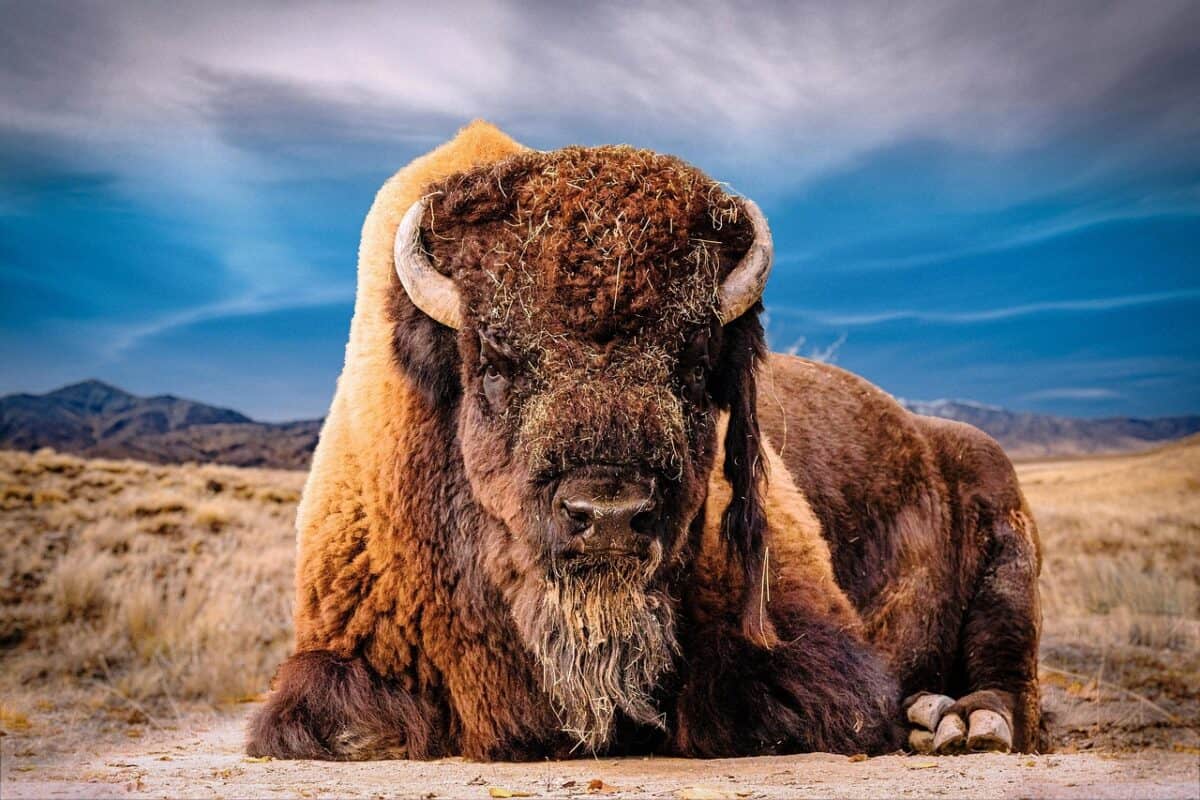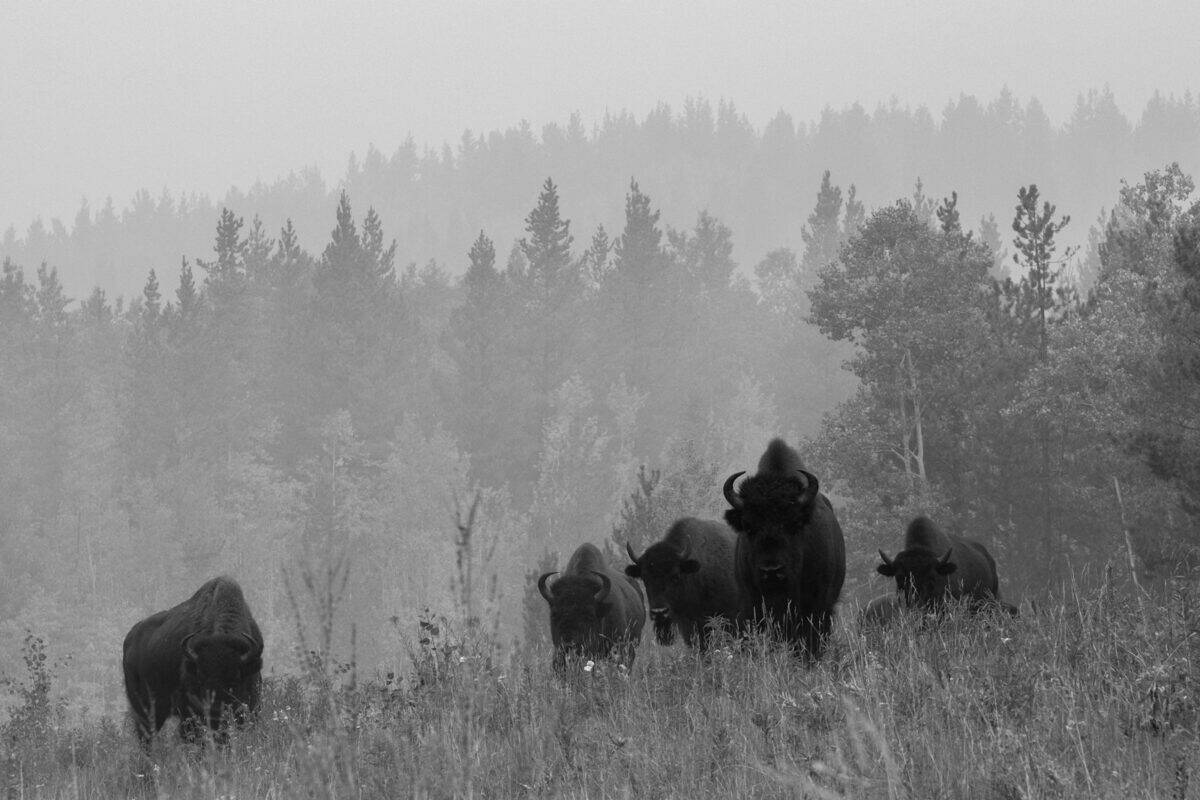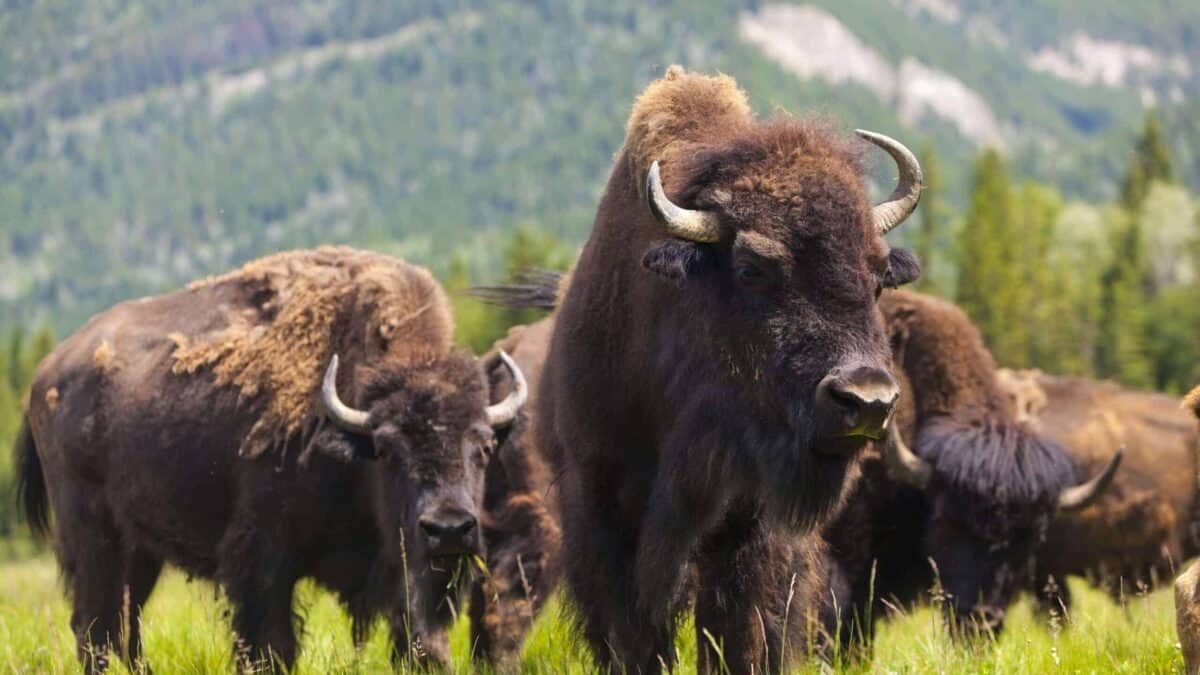Bison, the magnificent symbols of the American frontier, are far more complex creatures than many realize. While their imposing stature and historical significance are well-documented, their behavioral patterns and social dynamics remain mysteries to most people. These massive bovines, which once roamed North America in herds of millions, display fascinating behaviors that have helped them survive for thousands of years despite facing near extinction in the 19th century. Today’s recovering populations continue to exhibit these remarkable traits, offering researchers and wildlife enthusiasts incredible insights into one of America’s most iconic animals. From their sophisticated communication methods to their surprising agility, bison behavior reveals a species with depth and complexity far beyond their reputation as simply “buffalo.” Let’s explore twelve fascinating aspects of bison behavior that showcase why these animals deserve not only our protection but our admiration.
12. Bison Are Surprisingly Fast and Agile

Despite weighing up to 2,000 pounds, bison can reach speeds of 35-40 miles per hour, making them significantly faster than Olympic sprinters. This unexpected agility serves as both a defensive mechanism against predators and a means of traveling efficiently across vast grasslands. Their massive frames belie their athletic capabilities, as they can maintain these high speeds for extended periods and navigate rough terrain with remarkable ease.
Even more impressive is their ability to jump fences up to six feet high and turn on a dime despite their bulk. Bison can also swim across rivers with strong currents, using their powerful shoulders and legs to propel themselves through water. Wildlife managers and ranchers who work with bison must account for these athletic abilities when designing enclosures and handling facilities, as underestimating bison mobility has led to many escapes and dangerous situations throughout history.
11. They Communicate Through Body Language

Bison have developed a sophisticated system of non-verbal communication that helps maintain social order within their herds. Tail position serves as one of their primary indicators—a raised tail often signals alertness or potential aggression, while a tail hanging down typically indicates relaxation. Similarly, the position of their head provides important social cues: a lowered head with horns facing forward is a clear warning sign of an impending charge or confrontation.
During breeding season, bulls will display their strength through lateral displays, walking parallel to potential rivals with their bodies positioned to appear as large as possible. They also communicate through vocalizations ranging from deep grunts to bellows that can carry across the prairie. These sounds serve multiple purposes, from mating calls to warning signals when predators are detected. The combination of vocal and physical communication creates a complex social language that researchers are still working to fully understand.
10. They Form Democratic Herds

Unlike many herd animals with strict dominance hierarchies, bison engage in what researchers describe as “democratic” decision-making processes. When it’s time to move to new grazing grounds or water sources, adult female bison (cows) will begin pointing their bodies in the direction they believe the herd should travel. After sufficient “votes” have accumulated through this pointing behavior, the herd moves in the direction chosen by the majority, regardless of any individual’s social status within the group.
This collective decision-making process represents a remarkable adaptation that ensures decisions benefit the majority rather than serving the interests of a single dominant individual. Studies conducted at Yellowstone National Park have documented this voting behavior extensively, with researchers noting that it typically takes at least three adult females indicating the same direction before the herd begins to move. This system likely evolved as a survival mechanism that incorporates the knowledge and instincts of multiple experienced herd members rather than relying on a single leader.
9. Their Wallowing Behavior Serves Multiple Purposes

The distinctive behavior of bison rolling in dirt depressions—known as wallowing—serves far more complex purposes than merely scratching an itch. These wallows create shallow depressions in the prairie that fill with rainwater, creating microhabitats that support diverse plant and animal species. For the bison themselves, wallowing helps remove loose winter fur, provides relief from biting insects, and covers their skin with a protective layer of dust that acts as both sunscreen and insect repellent.
Beyond these practical benefits, wallowing also serves important social functions. Bulls often wallow before confrontations with rivals, covering themselves with dust and urine-soaked soil that may communicate status and reproductive readiness. Historical accounts from 19th-century travelers describe the Great Plains as being dotted with thousands of these wallow depressions, many of which remained visible for decades after bison populations were decimated. Modern restoration efforts have recognized the ecological importance of these wallows, with some conservation projects artificially creating wallows to encourage natural behaviors and support prairie ecosystem development.
8. They Care Collectively for Their Young

Bison have developed a communal approach to calf-rearing that increases survival rates in harsh environments. Unlike many mammals where mothers bear sole responsibility for offspring protection, bison herds form “nursery groups” where several mothers and their calves gather together. This arrangement allows multiple adults to watch for predators while others rest or feed, providing more consistent protection than individual parenting would allow. When danger threatens, adult bison form a protective ring around the calves, presenting their horns outward toward potential predators.
Interestingly, bison calves are sometimes cared for by females other than their mothers in a behavior known as “alloparenting.” This system ensures that if a mother is injured or killed, her calf won’t be left entirely vulnerable. Calves are precocial, able to stand within 30 minutes of birth and capable of keeping up with the herd within hours—a necessary adaptation for a migratory species that can’t afford to remain stationary for long. This combination of rapid development and communal protection has proven remarkably effective; in healthy herds, calf survival rates typically exceed 80% despite the many predators that target young bison.
7. They Engage in Play Behavior Throughout Life

Contrary to their serious, stoic image, bison regularly engage in playful behaviors that serve important developmental and social functions. Young calves can often be observed running in spontaneous “races,” jumping vertically in place (a behavior known as “pronking”), or engaging in mock fighting that helps develop the skills they’ll need as adults. These play sessions typically occur during dawn and dusk hours when temperatures are moderate and the herd is relatively settled.
Perhaps more surprising is that adult bison, particularly younger bulls, continue to engage in play throughout their lives. Researchers have documented mature bison sliding down snow-covered hillsides repeatedly, apparently for no purpose other than enjoyment. During winter, they’ve been observed using their massive heads to toss snow into the air or clearing paths through deep snow by running in circles. These behaviors suggest that play serves ongoing purposes in bison society beyond just juvenile development, possibly including stress relief, social bonding, and cognitive stimulation—similar to play functions observed in other intelligent social mammals.
6. They Practice Seasonal Migration Patterns

Before widespread habitat fragmentation, bison undertook some of North America’s most impressive land migrations, traveling hundreds of miles annually in response to seasonal changes. Unlike random wandering, these movements followed consistent patterns passed down through generations, with herds returning to the same calving grounds, summer ranges, and winter shelters year after year. Recent studies using GPS tracking in Yellowstone have revealed that modern bison continue these traditional movements despite having never witnessed the historic large-scale migrations of their ancestors.
This innate migratory behavior is increasingly recognized as crucial for both bison health and ecosystem function. As they move, bison transport nutrients across landscapes through their dung and urine, disperse plant seeds caught in their thick fur, and create disturbances that promote plant diversity. Conservation efforts are now focusing on creating protected corridors that allow bison to resume more natural movement patterns. Projects like the American Prairie Reserve in Montana aim to restore large-scale bison migration by connecting public and private lands, allowing bison to once again follow their ancestral pathways across the landscape as they did for thousands of years before European settlement.
5. They Modify Their Environment Through Grazing

Bison don’t just inhabit grasslands—they actively create and maintain them through their distinctive grazing patterns. Unlike cattle, which tend to graze areas uniformly, bison practice what ecologists call “patch grazing,” intensively feeding in one area before moving to another. This creates a mosaic of vegetation at different growth stages, supporting greater biodiversity than would exist without their presence. Their selective grazing helps prevent any single plant species from dominating the ecosystem, maintaining the open character of prairies that countless other species depend upon.
Their physical impact extends beyond just eating grass. Their hooves break up compacted soil and press seeds into the ground, improving germination rates. During winter, they use their massive heads to sweep aside snow, exposing vegetation that would otherwise be inaccessible—a behavior that benefits smaller mammals that follow in their wake. Conservation biologists now recognize bison as “ecosystem engineers” whose presence fundamentally alters habitat structure and function. This understanding has elevated their importance in restoration projects, with bison reintroduction increasingly seen as essential for recreating functioning prairie ecosystems rather than simply preserving the species itself.
4. They Can Predict Weather Changes

Long before meteorological instruments existed, Native American tribes observed bison behavior as a reliable weather forecasting system. Modern wildlife biologists have confirmed that bison display distinct behavioral changes hours before weather shifts occur. Before storms, bison typically increase their food intake and migrate to higher ground or protected areas. Conversely, when long cold periods are about to end, they often become more active and playful, anticipating the improved conditions to come.
This predictive ability likely stems from their exceptional sensory capabilities. Bison can detect barometric pressure changes that precede storms and may sense infrasound (low-frequency sound waves) produced by distant weather systems. Their heightened sense of smell also allows them to detect moisture changes in the air. For a species that evolved on open plains with little natural shelter, this weather sensitivity represented a crucial survival adaptation. Historical accounts describe how indigenous hunters would watch bison herds closely, knowing that sudden directional changes often signaled approaching blizzards or thunderstorms that could prove dangerous to humans without the bison’s cold-weather adaptations and predictive abilities.
3. They Exhibit Complex Mating Rituals

The bison breeding season, known as the rut, involves elaborate behavioral displays and social dynamics far more complex than simple competition between males. Beginning in late July and continuing through September, bull bison undergo dramatic physiological and behavioral changes. Their necks thicken, their temperaments become more aggressive, and they begin a behavior called “wallowing”—rolling in dirt mixed with their own urine to spread their scent. They also produce deep, bellowing vocalizations that can be heard over great distances across the prairie.
Rather than maintaining year-round harems like some hoofed mammals, bull bison compete for temporary breeding opportunities during this concentrated period. They engage in confrontational displays including parallel walking (sizing each other up side by side), head shaking, and pawing the ground before resorting to physical combat. Female bison play an active role in mate selection, often rejecting advances from multiple bulls before accepting a mate. Interestingly, research indicates that female bison prefer bulls that are attentive to herd defense, suggesting they select for traits beyond just physical dominance. After the intense rut period, bulls return to bachelor groups or solitary living until the following year’s breeding season.
2. They Form Bachelor Groups Outside Breeding Season

Outside the breeding season, male bison form distinct social units known as bachelor groups that function with their own complex social dynamics. These groups typically consist of 2-30 bulls of various ages, with younger males often learning from older, more experienced individuals. Within these bachelor groups, bulls establish loose dominance hierarchies primarily through ritualized displays rather than serious fighting, conserving energy and preventing injuries that could prove fatal in harsh conditions.
These bachelor groups serve multiple purposes beyond just social companionship. They provide collective protection against predators, efficient foraging strategies as bulls cooperate to clear snow in winter, and opportunities for play-fighting that helps maintain combat skills without the high stakes of breeding season confrontations. Research suggests these bachelor groups also function as information-sharing networks, with experienced bulls guiding younger ones to good grazing areas or water sources. The existence of these structured male social units contradicts the common misconception of bull bison as perpetually solitary and aggressive animals, revealing instead a species with sophisticated social structures adapted for different seasonal needs.
1. They Use Tools in Limited Circumstances

While not typically considered among tool-using animals, bison have been documented using environmental objects as tools in specific situations. Most notably, they use trees and rocks as scratching posts to relieve itching and remove parasites from areas they cannot reach with their hooves or mouth. They select appropriate objects based on their needs, with certain trees being heavily utilized until their bark is completely worn away. During winter, they’ve been observed using their heads to move fallen logs to access grass growing underneath.
Perhaps most fascinating is their use of snow as a tool. In extremely cold conditions, bison will intentionally cover themselves with fresh snow, which acts as insulation against even colder air temperatures due to snow’s ability to trap air and block wind—essentially creating natural blankets. They also use specific landscape features as tools for defense, positioning themselves near obstacles like trees or rocks during confrontations with predators to limit the angles of potential attack. While their tool use is not as elaborate as that seen in primates or corvids, it demonstrates problem-solving abilities and environmental manipulation that exceeds what many would expect from a large hoofed mammal.
Conclusion: The Complexity Behind Nature’s Living Tanks

The behaviors exhibited by bison reveal a species with remarkable depth and complexity that goes far beyond their reputation as merely impressive physical specimens. Their sophisticated social structures, communication systems, and environmental adaptations represent evolutionary solutions to the challenges of surviving on the North American plains. As we continue restoration efforts to bring bison back to their native landscapes, understanding these behavioral traits becomes increasingly important for both conservation success and appreciating the true nature of these iconic animals.
Modern research continues to uncover new aspects of bison behavior, challenging our assumptions and deepening our appreciation for a species that has played a pivotal role in North American ecosystems for thousands of years. Their near-extinction in the 19th century not only represented a tragic loss of biodiversity but also erased these behaviors from many landscapes where they once shaped environments and influenced countless other species. As bison populations slowly recover through conservation efforts, we have the opportunity to witness and learn from these remarkable behaviors once again.
By studying and appreciating the complexity of bison behavior, we gain not just scientific knowledge but a deeper connection to the natural history of North America and the sophisticated adaptations that allowed these animals to thrive for millennia. The thundering herds may never again reach their historic numbers, but in the behaviors of even small restored populations, we can glimpse the ecological relationships and evolutionary intelligence that made bison one of the most successful large mammals in North American history.
- 8 Times Animals Helped Solve Crimes in the Most Unexpected Ways - August 20, 2025
- 10 Stunning Animals You Can See in the Great Barrier Reef - August 20, 2025
- 14 Loudest Birds in the U.S. - August 20, 2025

